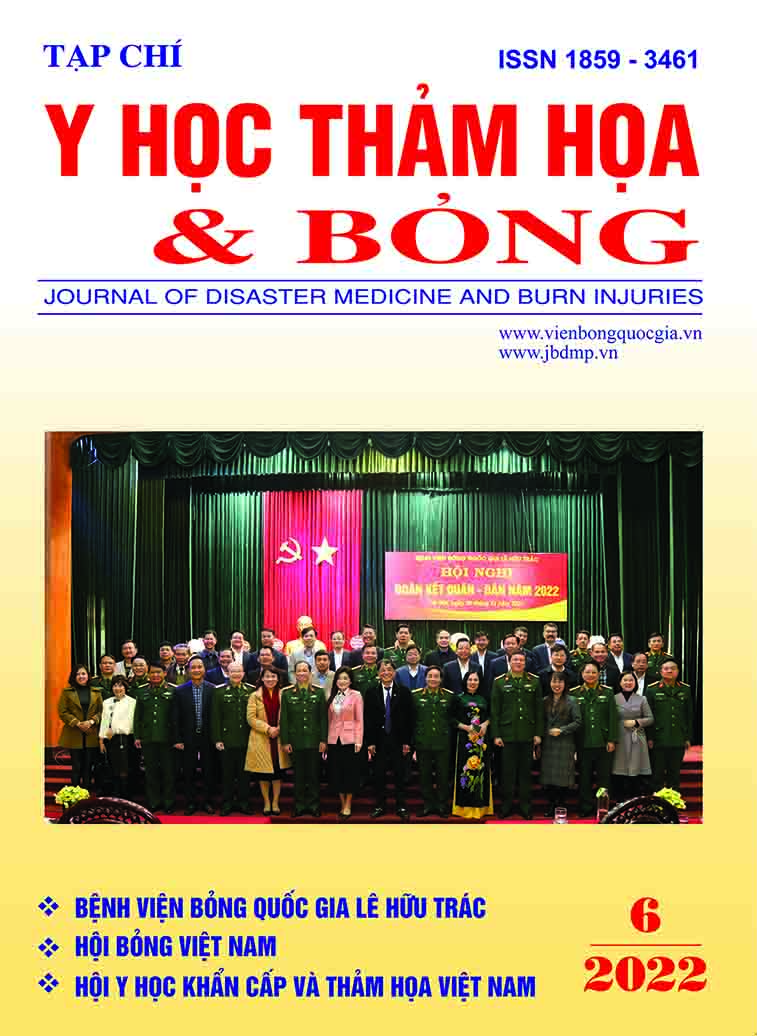Histopathological changes of experimental burns in rabbits treated with Berberine nano gel
Nội dung chính của bài viết
Tóm tắt
Berberin, isolated from Coscinium fenestratum and some plants in the family Ranunculaceae, has been shown to have healing effects on wounds, burns. Study to determine the effect of treatment of superficial burns in rabbits on the pathophysiology of burns of berberine nano gel produced by the National Burn Hospital.
The study was conducted on 45 rabbits, creating circular burns with a diameter of 4cm on both sides of the rabbit's back skin; rabbits were divided into 3 groups (15 rabbits, 30 burns/group), study group (A): Treated site by Berberin nano gel; control group (B): Treatment with SSD; Standard group (C): Treatment with Natri Chloride 0.9%. Follow-up histopathology at the rabbit burn site until the end of the study. Results: Group A burns had a lower number of inflammatory cells and a higher number of fibroblasts and blood vessels than group B and C burns. Conclusion: Berberin nano gel for treatment of superficial burns has been shown to have anti-inflammatory effects and stimulate wound healing.
Chi tiết bài viết
Từ khóa
Berberine nano gel, rabbit, superficial burns
Tài liệu tham khảo
2. D'Avignon LC, Hogan BK, Murray CK, Loo FL, Hospenthal DR, Cancio LC, et al. Contribution of bacterial and viral infections to attributable mortality in patients with severe burns: an autopsy series. Burns. 2010; 36:773-9.
3. OECD guideline for the testing of chemicals, 402, 2017.
4. Nguyễn Thị Tỵ (1989); tác dụng điều trị tại chỗ vết thương bỏng thực nghiệm của tinh dầu tràm và bước đầu ứng dụng lâm sàng, luận án PTS khoa học Y Dược, HVQY, Hà Nội
5. Danielle dos Santos Tavares Pereira, Maria Helena Madruga Lima-Ribeiro, Nicodemos Teles de Pontes-Filho, Ana Maria dos Anjos Carneiro-Leão, and Maria Tereza dos Santos Correia, Development of Animal Model for Studying Deep Second-Degree Thermal Burns; J Biomed Biotechnol. 2012; 2012: 460841.
6. Papp, K. Kiraly, M. Härmä, T. Lahtinen, A. Uusaro, E. Alhava; The progression of burn depth in experimental burns: a histological and methodological study; Burns 30 (2004) 684-690
7. Heimbach D, Mann R, Engrav L. Evaluation of the burn wound management decisions. In: Herndon D, editor. Total burn care. 2nd ed. Saunders; 2002. p. 101-8.
8. Heimbach D, Engrav L, Grube B, Marvin J. Burn depth: A review. World J Surg 1992;16:10-5.
9. Matthew P. Rowan, Leopoldo C. Cancio, Eric A. Elster, David M. Burmeister, Lloyd F. Rose, Shanmugasundaram Natesan, Rodney K. Chan, Robert J. Christy, and Kevin K. Chung, Burn wound healing and treatment: review and advancements; Crit Care. 2015; 19: 243.
10. Tabas I, Glass CK. Anti-inflammatory therapy in chronic disease: challenges and opportunities. Science. 2013;339: 166-72.
11. Arturson G. Forty years in burns research - the postburn inflammatory response. Burns. 2000; 26:599-604.
12. Edgar DW, Fish JS, Gomez M, Wood FM. Local and systemic treatments for acute edema after burn injury: a systematic review of the literature. J Burn Care Res. 2011;32:334-47.
13. Szpaderska AM, DiPietro LA. Inflammation in surgical wound healing: friend or foe? Surgery. 2005; 137:571-3.
14. Ang ESW, Lee ST, Gan CSG (2001), Evaluating the role of alternative therapy in burn wound management: randomized trial comparing mois exposed burn ointment with conventional method in the management of patients with second-degree burns, Medscape general medicine: 3 (12) 3 -18.
15. Chilikuoa, Chin-Wen Chiab, et al (2004), The anti-inflammatory potential of berberine in vitro and in vivo, Cancer letters, Volume 203, Issue 2, Pag. 127-137.
16. Sarna LK, Wu N, Hwang SJ, et al (2010), Berberine inhibits NADPH oxidase mediated superoxide anion production in macrophages; Can. J. Physiol. Pharmacol. 88(3): 369 -378.
17. Ckless K, Schlottfeldt JL, Pasqual M, et al (1995), Inhibition of in-vitro lymphocyte transformation by the isoquinoline alkaloid berberine. J Pharm Pharmacol; 47:1029 - 1031.
18. Jeong HW, Hsu KC, Lee JW, et al (2009), Berberine suppresses proinflammatory responses through AMPK activation in macrophages, Am J Physiol Endocrinol Metab296: E955-E964.
19. Reinke JM, Sorg H. Wound repair and regeneration. Eur Surg Res. 2012;49:35-43.
20. Werner S, Krieg T, Smola H. Keratinocyte-fibroblast interactions in wound healing. J Invest Dermatol. 2007;127:998-1008.
21. Pastar I, Stojadinovic O, Yin NC, Ramirez H, Nusbaum AG, Sawaya A, et al. Epithelialization in wound healing: a comprehensive review. Adv Wound Care. 2014;3:445-64.
22. Bộ môn Bỏng - Học viện Quân Y, Liền vết thương, Giáo trình Bỏng (dùng cho đào tạo trình độ Sau đại học), NXB Quân đội Nhân dân, 2018, trang70-90.
23. P.I. Jewo, I.O.F., O.S. Babalola, L.C. Saalu, A.S. Benebo, M.C. Izegbu, and O.A. Ashiru; A Comparative Study of the Wound Healing Properties of Moist Exposed Burn Ointment (MEBO) and Silver Sulphadiazine. Ann Burns Fire Disasters, 2009. 22(2): p. 79-82.
24. Nasef M, K.H.A., Ashour M A, Nassar S L, Selim N M, El-Raey M A; Biological Investigations of a New Natural Recipe Expected to Promote Healing of Superficial Burns; International Journal of Pharmaceutical and Clinical Research 2016. 8(8): p. 1230-1239


